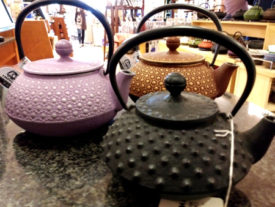What is Iwachu?

Cast iron teapots or “tetsubin”, are one of the most traditionally Japanese artifacts and have been widely accepted around the world. They are traditionally heated over a charcoal fire and are used for boiling and pouring hot water for drinking purposes. Because of the heat source, iron is released from the pot and into the water. Some people claim that it adds a type of sweetness, and it also adds extra flavor to the tea. Using cast iron teapots also releases iron into the water which can be used as a dietary source of the mineral.
Cast iron teapots are often elaborately decorated with different designs on the outside of the pot. The different symbols represent different meaning, such as happiness, strength and joy, or the occasional blessing. Nature is also found within the line of decorations as well. The pots come in a variety of colors, and shapes, as well as different sizes. The inside of the pots, have been glazed with enamel, in order to lend itself to making brewed tea easy to clean and extend the life of the pot.
One of the most famous brand of pots is the Iwachu, and has been around for hundreds of years. The craftsmen are located in Morioka city, Japan, and has been on the most well-known and respected manufacturers of the modern Nanbu ironware. Today, the craftsmen behind Iwacha pay respect to the traditional method of hand-made precision pots through every stage of manufacturing.
The production process of making Tetsubin pots usually consist of 64 to 68 steps. The entire process is still strickly maintained by hand and controlled by a master craftsman known as a “kamashi”. It requires at least 15 years to become a full-fledged craftsman, and 30-40 years to become a master.
Source: www.everabundant.blogspot.com/2011/06/introduction-and-history-of-cast-iron.html

